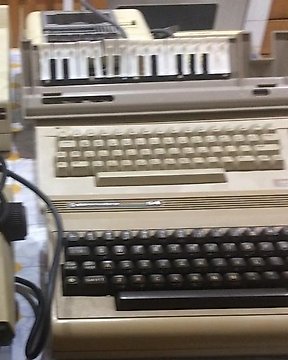
Commodore - Vintage Computer
Nr. 73659609

Nr. 73659609

What I am presenting in this auction is an electronic object that is quite sought after by collectors.
The object in question is the COMMODORE 64/4 PLUS.
ATTENTION!!!
THE IMAGES I PUBLISHED are for illustrative purposes because the device has never been opened.
The images were captured on the internet and I put the most neutral ones possible.
The origin of the Commodore is a stock fund from my uncle's HI-FI shop who is about to retire and he has delegated me to put it up for auction.
The Commodore 64/4 plus, presents itself as it is, in fact there is nothing to say about it because it is NEW, IT HAS NEVER BEEN OPENED OR TURNED ON in fact, on its brown box where the electronic device is kept, there is an inscription “ARNOLDO MONDADORI EDITORE”, he was the authorized distributor.
Inside the box, there is the Commodore, its power supply and its instruction manual all still sealed.
So the Commodore, in addition to being vintage and rare, IS UNIQUE IN THE WORLD IN ITS STATE OF CONSERVATION, so don't pay attention to the price and if YOU WOULD LIKE TO MAKE AN OFFER OR RELAUNCH, DO NOT HESITATE AT ALL BECAUSE IT IS AN UNREPEATABLE OPPORTUNITY and who will win this lot, you may be lucky enough to have in your possession a UNIQUE object IN THE WORLD!!!
Talking a little about the Commodore, I start by saying that it was designed by Jack Tramiel towards the end of 1982, it was presented at the 1984 International Summer Consumer Electronics Show.
The retail sale began in the United States in June 1984 while in Italy, its marketing took place in November 1984 and they were produced until 1986.
Overall, around 400,000 units were sold worldwide, 150,000 units were sold in America alone, and the remaining units in the rest of the world.
The characteristics of the Plus/4, presented 64K of RAM and a considerable amount of ROM memory as, in addition to containing the KERNAL, the heart of the operating system of Commodore computers, the BASIC interpreter and the character generator, the ROM contained even personal productivity software. The presentation screen was very similar to that of the Commodore 16, with the only variant of declaring 60671 free bytes against the 12277 of the Commodore 16, and with the addition of the wording "3-PLUS-1 ON KEY F1".
The Plus/4 was in fact equipped with 3-Plus-1 personal productivity software, programmed by David W. Johnson of International Tri Micro Incorporated. By pressing the F1 key or issuing the SYS 1525 command, it was possible to access the complete package, immediately available because it was preloaded in a special ROM and included a word processing program, a spreadsheet and a database manager, integrated with each other. However, these applications proved to be of poor quality having to coexist in only 16K and were little used, also because they did not provide tape drive support, but only that of the disk drive.
Dynamic memory management allowed to have a lot of free space for BASIC programs (about 60K). The interpreter used was BASIC 3.5. There were specialized commands for I/O, graphics, and sound, as well as a very useful machine language assembler/disassembler (TEDmon). All of which was a major improvement over the C64. Add to this the remarkable palette offered by TED, 121 colors, which was a lot for that time, and the possibility of dividing the text area into windows, independent of each other, where it is possible to concentrate portions of text separately.
On the other hand, the absence of a synthesizer up to par and the absence of sprites, combined with a high cost, decreed the failure of this machine, undoubtedly also due to unfortunate choices on the connectors to connect some peripherals, which made difficult to use peripherals with standard connectors. For example, joysticks use mini-DIN type connectors designed to reduce RF interference; likewise the connector of the recorder was not the same used in the VIC-20 and in the Commodore 64.
So kaufen Sie auf Catawiki
1. Etwas Besonderes entdecken
2. Höchstgebot abgeben
3. Sichere Zahlung durchführen